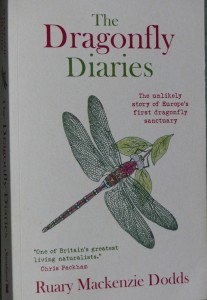 I promised this year that I would learn more about bees and butterflies and not buy any books. Then I found a copy of Ruary Mackenzie Dodds’ book at a reduced price and all my good intentions went out of the window (this was a book that was already on my to read list).
I promised this year that I would learn more about bees and butterflies and not buy any books. Then I found a copy of Ruary Mackenzie Dodds’ book at a reduced price and all my good intentions went out of the window (this was a book that was already on my to read list).
This is not a book about dragonflies though. It is a book about the author pursuing a dream and establishing a dragonfly sanctuary and, later, a dragonfly museum and, bizarrely, a museum of old farm and estate equipment. Don’t get me wrong, the dragonflies get many mentions, and there is some information about them, about their requirements and they really are the author’s raison d’être but if you want to learn about dragonflies then this is not the book for you. After saying what it isn’t, then it is only fair to say that what it is is very engaging nature writing and story telling.
Ruary Mackenzie Dodds had what many would call an epiphany when out taking photographs near a canal in London during a lunch break when a dragonfly landed on his shirt. Before that moment, he’d never even noticed them. Over the next few years, after discovering that dragonflies were under threat, he came up with a plan to create a dragonfly sanctuary. It helped that his girlfriend was the niece of Dame Miriam Rothschild who happened, along with her son, to own the large estate that once belonged to Charles Rothschild who created what has now become the Wildlife Trusts. In addition, being an incredibly well known entomologist, Miriam Rothschild also knew anyone who knew anything about dragonflies.
Whilst this was probably the main reason that the venture got off the ground, it required an awful lot of hard work, vision, cajoling and recruitment of volunteers to get the sanctuary off the ground and this is the story of how he went about it. By the end of the book, twenty three years later an awful lot had been achieved including the creation of a charity, the restoration of vast amounts of farm machinery, not to mention one of the first sets of electricity generating equipment circa 1900, and a lot of education of the public about dragonflies. Most remarkable is the ability to attract funding and volunteers from all walks of life, and to keep them volunteering (although it appears there was more than a bit of luck preventing quite a few accidents).
All in all this is inspiring stuff, and whilst most of us cannot create anything on the scale of the author’s achievements, it did make me wonder just what I could achieve. Hmmm, time will tell. In the meantime, the wonderful writing style has at least motivated me to get blogging again and to dust off my Field Guide to the Dragonflies of Britain and Ireland.